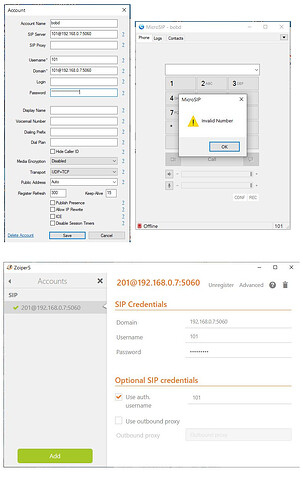Greetings,
I finished setting up a new instance of FreePBX 17.0.21 on a Ubuntu 24.04.3 LTS VM under VMWare.
I had multiple issues, like so many other newbies to FreePBX I assume.
Anyway, I managed to get it installed and seemingly functioning correctly.
My goal is absolutely the simplest configuration ever with only one mobile phone using a wireless connection to my local LAN and a Win 10 desktop machine also on the local LAN, or 2 desktop machines on the LAN.
Doesn’t get any simpler.
I do not want ANY outside the LAN connections involved, and really NO cell phone actual phone number involved. If the mobile can’t do this, then I will only use 2 desktop machines with no mobile phone at all.
I wish to be able to use some softphone software on the LAN devices to connect to my instance of FreePBX and be able to call extensions and leave/retrieve voice messages.
I can access the server http://192.168.0.7/admin link in a browser from the anywhere on the LAN and the administration screens seem to function fine. The dashboard shows as it should I believe and System Alerts No critical issues.
I configured 2 users and 2 extensions seemingly ok.
I had some issues with the password limits complications, but overcame the gumbo successfully I believe.
In any event, the server looks fine, I can enter the UCP screens via a browser using either users credentials and all seems fine. I can do this from any device on the LAN and so access to the server from the LAN does not seem to be an issue either with desktops or mobile phones attached via wireless to the LAN.
My problem is this.
I have tried multiple softphone apps on the mobile phone and multiple progs on the desktop and none of them can connect to the server using either username/pwd.
They all seem to fail on authentication. I am using only the IP of the FPBX server and the user name/password in these softphone progs. I am not even trying any app that requires an account configuration. I intend to keep all on the LAN ONLY behind my firewall and NO data will go anywhere except on my LAN so nothing can phone home in any way.
Some of the softphone stuff requires a “domain” with absolutely no explanation whatsoever. Very confusing. Does not seem to be any reference to “domain” in all the FreePBX stuff or documentation so I am lost on this.
Can anyone give me any assistance here ?
I must have not configured right, but lacking any direction, I am a bit lost.
Do I need to set up a Trunk ? Dunno, not sure what a Trunk is for, cant find newbie readable explanations for it.
In going through the configs for a Trunk, it seemed to me that I did not need one setup for my requirements. So I left it unconfigured.
The few howto’s I found kind of leave one hanging after the system is configured and one can access the web admin UI. None of them really explain configurations well if at all that I found.
What is the absolute minimum setup to allow for 2 extensions as simple as possible ?

